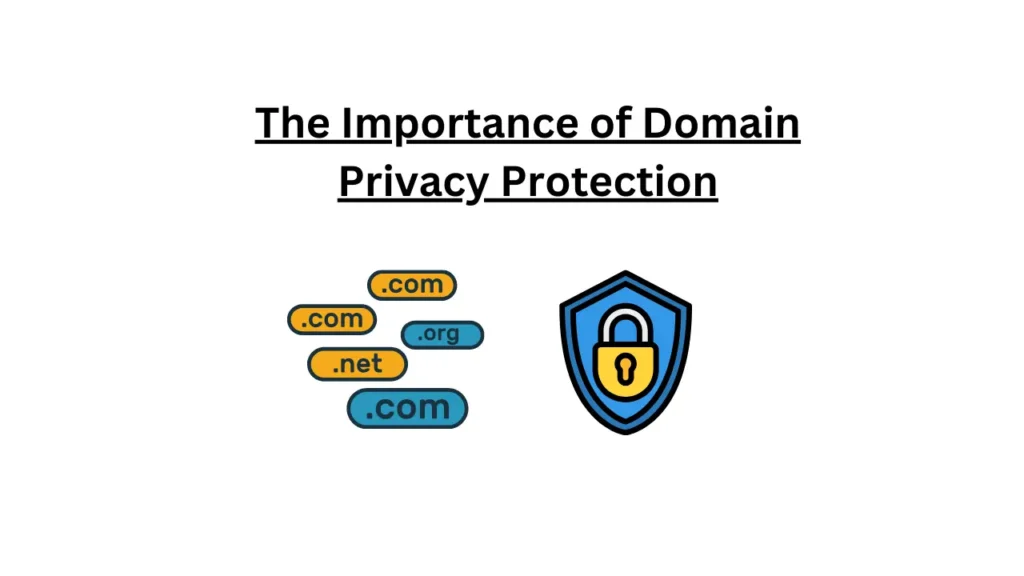Introduction: Why Domain Privacy Matters
Imagine this: You’ve finally launched your dream website, and excitement is in the air. But then, the unexpected happens—your inbox floods with unsolicited emails, and your phone won’t stop ringing with calls from strangers offering you services you didn’t ask for. All this could have been avoided with a simple, yet often overlooked, step: domain privacy protection.
You might be wondering what exactly domain privacy protection is and why it’s so essential. When you register a domain name, your personal information, such as your name, address, phone number, and email address, becomes publicly available through the WHOIS database. This can lead to a myriad of problems, including spam, unwanted solicitations, or even identity theft. By opting for domain privacy protection, this sensitive information is kept private and replaced with the contact information of a proxy service provider.

So, why does this matter to you? In today’s digital age, where almost everyone owns at least one personalized domain, maintaining your online privacy has never been more crucial. Not only does it shield you from unnecessary disturbances, but it also helps protect your personal and financial information from falling into the wrong hands. Furthermore, it places you in control, allowing you to decide who gets access to your contact details.
By now, you can see that domain privacy protection isn’t just a techie jargon but a practical solution for anyone owning a domain. Whether you’re a business owner, a blogger, or someone with a personal website, understanding and implementing domain privacy protection can save you from headaches down the road. So let’s delve deeper into the concepts and benefits behind maintaining the privacy of your domain and how it can provide peace of mind in our increasingly connected world.
- What is Domain Privacy Protection?
- How Domain Privacy Works
- Consequences of Not Using Domain Privacy
- How to Set Up Domain Privacy Protection
- 1. Log in to Your Domain Registrar Account
- 2. Navigate to Your Domain Settings
- 3. Find Privacy Protection Options
- 4. Enable Privacy Protection
- 5. Review Your Information
- 6. Save Your Changes
- Comparing Providers: Which One Should You Choose?
- Common Myths About Domain Privacy Protection
- Conclusion: Keep Your Domain and Data Safe
- FAQ: Common Queries About Domain Privacy Protection
What is Domain Privacy Protection?
Domain privacy protection is a service provided by domain registrars to keep the personal information of website owners private. When you register a domain, your personal details, such as your name, address, phone number, and email, are recorded in the public WHOIS database. This information is accessible to anyone who wishes to see it, which can lead to various unwanted consequences.
Imagine domain privacy protection as a lock on your door or a password on your phone. Just as these measures keep your home and personal device secure, domain privacy protection shields your personal information from prying eyes and malicious intent. Essentially, it acts as a barrier, keeping your private data confidential and only accessible to authorized parties.
By masking your personal information, domain privacy protection ensures that spammers, identity thieves, and data scrapers cannot easily access your details. This protection is crucial not only for maintaining privacy but also for safeguarding your identity and ensuring the smooth operation of your website without the interference of unsolicited contact or cyber threats.
Here are some key benefits of domain privacy protection:
- Preventing Spam: Reduces the amount of unwanted emails, calls, and messages by keeping your contact information hidden from spammers.
- Reducing Risk of Identity Theft: Criminals cannot easily access your personal information, thereby minimizing the risk of identity theft and related fraud.
- Protecting Against Data Scraping: Data miners and scrapers cannot collect and misuse your personal data for their own purposes.
In conclusion, domain privacy protection is an essential service that every website owner should consider. By keeping your personal information private, it provides a layer of security and peace of mind, allowing you to focus on managing and growing your online presence without worrying about privacy breaches.
How Domain Privacy Works
When you register a domain, all your contact details such as your name, address, phone number, and email address are entered into the WHOIS database. This information is accessible to anyone with an internet connection, unless you take measures to protect it. This is where domain privacy protection steps in, acting like a superhero cape concealing your business’s secret identity.
Domain privacy protection services substitute your actual information with that of a forwarding service. Essentially, the contact details listed in the WHOIS database will not reveal your identity or personal information. Instead, they will display the contact information of the privacy service provider, effectively shielding your real details from prying eyes.
Here’s a closer look at how domain privacy protection functions:
| Main Function | Details |
|---|---|
| WHOIS Information Protection | Your personal contact details are hidden and replaced with the information of the privacy service provider. |
| Spam Prevention | Since your actual email address isn’t public, you’re less likely to receive spam and unsolicited emails. |
| Cybersecurity Enhancement | Protects against domain-related threats like phishing attacks and identity theft, safeguarding your personal and business data. |
To put it plainly, domain privacy protection offers a layer of anonymity and security, making your personal information inaccessible to the public. This pivotal function can help you avoid unwanted solicitations, reduce the risk of cyber-attacks, and maintain the confidentiality of your personal data.“`html
Consequences of Not Using Domain Privacy
Neglecting domain privacy protection can open a Pandora’s box of unfortunate events. Consider your domain registration details as the keys to your digital kingdom; without proper safeguards, anyone can access these keys, generating a parade of unwanted consequences. One of the most common and exasperating outcomes is an inundation of spam emails. Your email address, listed publicly in the WHOIS database, becomes an easy target for marketers eager to peddle everything from dubious software to unsolicited investment opportunities. Your inbox, once a serene oasis of relevance, transforms into a chaotic landfill of digital detritus.
Beyond the nuisance of spam, failing to employ domain privacy protection can expose you to more sinister threats like identity theft. Cybercriminals can exploit publicly available registration details to piece together your personal information. A shocking report revealed that over 60% of small businesses that faced identity-related breaches encountered operational disruptions or significant financial losses. The cost of such an oversight can be astronomically high, jeopardizing not just your digital assets but your hard-earned reputation.
Another tangible risk is the onslaught of unwanted solicitations. Vendors and service providers, noting your domain registration, might bombard you with unwanted calls and offers. Imagine trying to focus on your next big project while your phone buzzes incessantly with gimmicky sales pitches. It doesn’t just drain your productivity; it also frays your patience and sanity.
Consider the case of a well-known blogger who neglected to activate domain privacy protection. Before long, they were battling incessant spam, dealing with fraudulent credit card charges, and fending off relentless telemarketers. Their story serves as a cautionary tale of how failing to implement robust security measures can disrupt not just your business but your peace of mind.
In essence, choosing not to enable domain privacy protection is akin to leaving your front door wide open for intruders. The safeguards are not merely optional accessories; they are essential defenses to protect your digital identity and ensure a seamless, secure online presence.“`
How to Set Up Domain Privacy Protection
Setting up domain privacy protection is a crucial step in securing your online presence. With clear and concise instructions, even those new to domain management can follow along effortlessly. Below is a step-by-step guide on how to enable domain privacy protection. It’s recommended to use visuals, such as screenshots or infographics, to further simplify the process for users.
1. Log in to Your Domain Registrar Account
First, log in to the account where you registered your domain. This is typically done through the website of your domain registrar. If unsure which registrar you used, check your email for a registration confirmation.
2. Navigate to Your Domain Settings
Once logged in, locate the settings or management section for your domain. This is often found under headings like “My Domains” or “Domain Management.”
3. Find Privacy Protection Options
Within your domain settings, search for options related to privacy. This might be labeled as “Privacy Protection,” “Domain Privacy,” or “WHOIS Privacy.”
4. Enable Privacy Protection
Click on the option to enable privacy protection. You may be prompted to confirm your choice or select a privacy plan. Follow the on-screen prompts to complete the setup.
5. Review Your Information
After enabling privacy protection, review the information to ensure your personal details are now hidden from public view. Your registrant information should now be replaced with the registrar’s proxy details.
6. Save Your Changes
Finally, save any changes made during the process. Keep an eye out for email confirmations from your registrar regarding the activation of privacy protection.
By following these steps, you can effectively set up domain privacy protection, ensuring your personal information remains secure and out of the hands of unauthorized parties.
Comparing Providers: Which One Should You Choose?
Deciding on a domain privacy protection provider can be as tricky as trying to remember if it’s a “bad hair day” or just your usual look. With the multitude of options available, it helps to have a clear comparison laid out before you. Below is a brief analysis of three leading providers—Provider A, Provider B, and Provider C—highlighting their cost, features, user reviews, and additional services.
| Provider | Cost | Key Features | User Reviews | Additional Services |
|---|---|---|---|---|
| Provider A | $$ | Unlimited email forwarding, Basic spam protection | 4.5/5 | Website builder, SEO tools |
| Provider B | $$$ | Advanced spam protection, Dynamic DNS service | 4.2/5 | Cloud storage, SSL certificates |
| Provider C | $ | Email forwarding, Basic DNS management | 4.0/5 | Free domain with annual plans, Customer support |
Provider A is often lauded for its user-friendly interface and solid core features. While it might not bring all the bells and whistles, it gets the job done at a reasonable price. The added benefit of website building tools and SEO capabilities makes it an attractive choice for small business owners looking to establish and grow their online presence.
Provider B tends to be the go-to for those who demand more advanced protection. Although it is slightly more expensive, the enhanced security features and additional offerings such as cloud storage make it worthwhile for those with more complex needs. User reviews are generally positive, praising the seamless experience and high level of professional support.
Provider C offers a budget-friendly solution without compromising too much on essential features. This provider is known for its straightforward, no-frills approach. While it doesn’t offer as many extra services as the others, its cost-effective plans and reliable customer service make it a good choice for personal use or small-scale projects.
The key to choosing the right provider is understanding your specific needs. Whether you prioritize cost, advanced features, or additional services, each provider has something unique to offer. Armed with this comparison, you’re better equipped to make an informed decision that fits both your budget and requirements.“`html
Common Myths About Domain Privacy Protection
Many misconceptions and myths surround domain privacy protection. To set the record straight, let’s take a closer look at some of the most common myths and the facts that debunk them:
Myth 1: “It’s too expensive.”
One of the most prevailing myths is that domain privacy protection will break the bank. While it’s true that it requires an additional fee, it is a relatively modest investment. Think of it as a small price to pay to keep your personal information safe from prying eyes. Taking the cost into account, isn’t your privacy worth it?
Myth 2: “It doesn’t really work.”
Another common belief is that domain privacy protection doesn’t offer real security benefits. This couldn’t be further from the truth! When you opt for domain privacy protection, your contact information is replaced with that of the privacy service provider. This ensures that anyone performing a whois search will see the provider’s contact details instead of yours, significantly reducing the risk of spam, scams, and identity theft.
Myth 3: “Only big companies need it.”
A widespread misconception is that only large enterprises or online giants need domain privacy protection. However, whether you’re an individual, a startup, or a small business, protecting your personal information is crucial. Cyber threats don’t discriminate based on the size of the organization. Hence, everyone can benefit from an added layer of protection.
Myth 4: “It’s just a marketing gimmick.”
Some believe that domain privacy protection is nothing more than a marketing strategy to make extra money. This cynical view dismisses the genuine security and privacy risks that exist online. The service is designed to address the very real threats that come with having your contact details publicly available.
In conclusion, understanding domain privacy protection is essential in the digital age, where personal data is as valuable as currency. By debunking these myths, we hope you recognize the importance and efficacy of this valuable service.“`
Conclusion: Keep Your Domain and Data Safe
Protecting your domain privacy is paramount in today’s digital age. Throughout this article, we have explored the various facets and significance of domain privacy protection, emphasizing its role in safeguarding personal and business data. By concealing your contact information from public WHOIS databases, you can significantly mitigate risks such as identity theft, spam, and cyber-attacks.
The key points highlighted include understanding the basics of domain privacy protection, recognizing its benefits, and knowing the risks associated with neglecting it. We also delved into the legal implications and compliance requirements, stressing the importance of staying updated with regulations to avoid potential penalties.
Now is the time to take proactive steps to secure your domain privacy. A simple action, such as checking and updating your domain privacy settings, can make a considerable difference in enhancing your online security. Many domain registrars offer privacy protection services, making it a straightforward process to activate and maintain.
To ensure comprehensive domain privacy protection, remember to regularly review and update your contact information, monitor your domain’s status, and stay informed about new security practices and tools provided by your registrar.
By prioritizing domain privacy protection, you set a strong foundation for a secure and privacy-conscious online presence. Keep your domain and data safe, and stay vigilant against any threats that may compromise your personal or business information.
Take action today—check your domain privacy settings and make necessary updates. Your future self will thank you for taking these steps to protect your digital identity.“`html
FAQ: Common Queries About Domain Privacy Protection
Is domain privacy protection mandatory?
Domain privacy protection is not mandatory, but it is highly recommended. While it is optional, choosing to enable it can help protect your personal information from being publicly accessible in the WHOIS database. This additional layer of security can prevent spam, identity theft, and unwanted solicitations.
How much does domain privacy protection typically cost?
The cost of domain privacy protection can vary depending on the registrar. Generally, it ranges from $10 to $15 per year. Some registrars might offer it as a part of a package deal with domain registration. The investment is minimal compared to the potential risks and privacy benefits it provides.
Can I add domain privacy protection to an existing domain?
Yes, domain privacy protection can usually be added to an existing domain at any time. Most registrars provide an option to enable this service through their user dashboard. By enabling it, the registrar replaces your personal contact information with their own proxy contact information, offering you enhanced privacy.
Will domain privacy protection affect my website’s operation?
No, domain privacy protection does not impact your website’s operation or accessibility. It solely affects the visibility of your contact information within the WHOIS database. Your website will continue to function normally while providing you with increased privacy and security.
What happens if I forget to renew domain privacy protection?
If you forget to renew your domain privacy protection, your personal contact details will become publicly available in the WHOIS database once it expires. To avoid this, set up automatic renewal or frequently check your registrar settings to ensure continuous protection.“`


